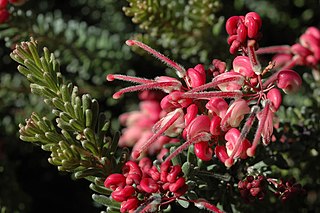
Grevillea lanigera, commonly known as woolly grevillea, is a species of flowering plant in the family Proteaceae and is endemic to south-eastern continental Australia. It is a spreading shrub with narrowly oblong to more or less linear leaves and clusters of pink to red, and cream-coloured flowers.
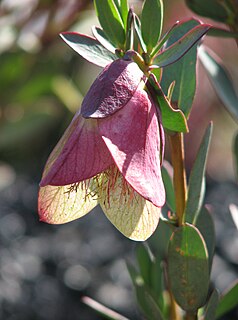
Pimelea physodes, commonly known as Qualup bell, is a species of shrub that is endemic to Western Australia. It has egg-shaped to narrow elliptical leaves and distinctive bell-like inflorescences with tiny greenish flowers surrounded by long elliptical bracts. The inflorescence resembles those of some of the only distantly-related darwinia "bells" and the bracts are a combination of red, purple, green and cream-coloured.
Grevillea hockingsii is a species of flowering plant in the family Proteaceae and is endemic to south-eastern Queensland. It is an erect shrub with oblong to narrowly elliptic leaves and clusters of reddish-pink flowers.
Grevillea kedumbensis is a species of flowering plant in the family Proteaceae and is endemic to a restricted locale in the Great Dividing Range in central New South Wales in Australia. It is a twiggy shrub with narrowly elliptic to egg-shaped leaves with the narrower end towards the base, and clusters of hairy green to cream-coloured flowers.

Grevillea helmsiae, commonly known as Helms' grevillea, is a species of flowering plant in the family Proteaceae and is endemic to Queensland. It is a shrub or tree with elliptic to narrowly egg-shaped leaves with the narrower end towards the base and small clusters of white to cream-coloured flowers with a green style.
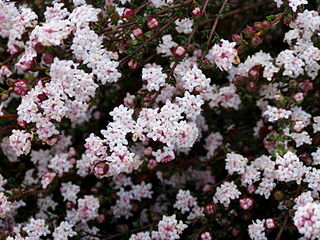
Pimelea brachyphylla is a species of small shrub that belongs to the family Thymelaeaceae. It is endemic to Western Australia. It is not considered to be threatened at this time.

Pimelea sericea is a species of shrub in the family Thymelaeaceae. It is native to Australia, specifically Tasmania. Their common name is mountain rice flower. Pimelea means fat and sericea means silk. The reason could be that Pimelea species usually have oily seeds and fleshy cotyledon. The sericea came from the fact that they are covered with silky hair.

Hakea lasianthoides is a shrub or tree in the family Proteaceae and is endemic to Western Australia. It has creamy-white flowers, mostly linear leaves and flowers from September to November.

Grevillea hislopii is a species of flowering plant in the family Proteaceae and is endemic to a restricted area of the south-west of Western Australia. It is a dense, single-stemmed shrub with linear to narrow elliptic leaves and clusters of hairy, whitish-grey flowers.

Petrophile antecedens is a species of flowering plant in the family Proteaceae and is endemic to southwestern Western Australia. It is a small, erect, open shrub with sharply-pointed, cylindrical leaves and spherical heads of hairy, pale cream-coloured flowers.
Petrophile clavata is a species of flowering plant in the family Proteaceae and is endemic to southwestern Western Australia. It is a shrub with curved, needle-shaped, sharply-pointed leaves and spherical heads of hairy, cream-coloured to very pale yellow flowers.
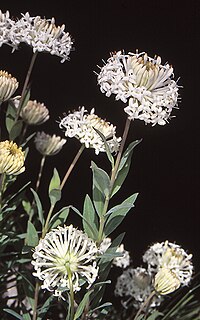
Pimelea treyvaudii, commonly known as grey rice-flower, is a species of shrub in the family Thymelaeaceae. It has white flowers in spherical heads at the end of branches and is endemic to eastern Australia.
Pimelea pagophila, commonly known as the Grampians rice-flower, is a species of shrub in the family Thymelaeaceae. It has a restricted distribution, white flowers in spherical heads at the end of branches, green leaves arranged in opposite pairs and is endemic to Victoria, Australia.

Pimelea aeruginosa is a species of small shrub in the family Thymelaeaceae. It is a small shrub with yellow flowers and is endemic to Western Australia.

Pimelea ammocharis is a species of small shrub in the family Thymelaeaceae. It is a small shrub with white-yellow to orange flowers and is endemic to Western Australia.
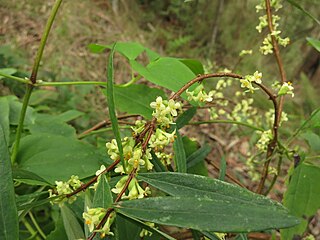
Pimelea axiflora, commonly known as bootlace bush, is a small shrub in the family Thymelaeaceae and is endemic to Australia. It is a small shrub with whitish flowers on mostly smooth stems.
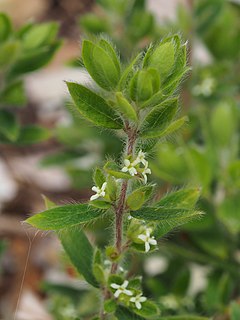
Pimelea venosa, commonly known as Bolivia Hill rice-flower, is a flowering plant in the family Thymelaeaceae and is endemic to a restricted area of New South Wales. It is an erect shrub with densely long-hairy stems and leaves, elliptic to lance-shaped leaves and small groups of white flowers.
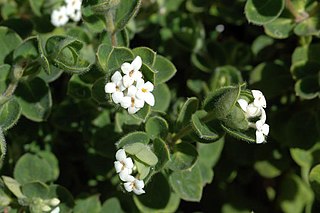
Pimelea altior is a species of flowering plant in the family Thymelaeaceae and is endemic to eastern Australia. It is a shrub with elliptic leaves and heads of white, tube-shaped flowers.
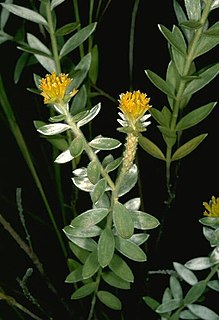
Pimelea amabilis is a species of flowering plant in the family Thymelaeaceae and is endemic to northern Queensland. It is a small shrub with narrowly elliptic or elliptic leaves and spikes of hairy, yellowy-green or yellow, tube-shaped flowers.
Pimelea approximans is a species of flowering plant in the family Thymelaeaceae and is endemic to northern Queensland. It is a perennial shrub with elliptic leaves and spikes of hairy, yellow, tube-shaped flowers.














